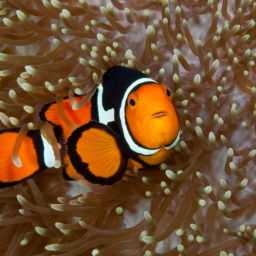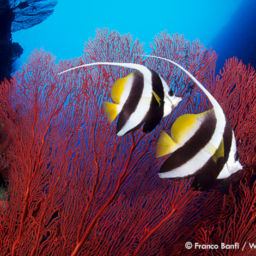The reefs and wrecks of Madang, Papua New Guinea, are home to a diverse variety of marine life. Reef sharks, pelagic fish, nudibranchs, sea snakes, groupers, seahorses, stingrays, and a rich assortment of reef fishes are commonplace. But far and away the most unique marine animal we encountered while scuba diving in Madang was a little shark that walks on its fins and is found only in this region — the hooded epaulette shark.
Where is Madang?
Divers traveling to this wild and exotic country often overlook the scuba diving in Madang, located on the northern coast of the main island. But, located as it is on the shores of a huge lagoon, which is dotted with reefs and pretty islands, Madang offers a wealth of wonderful dive sites.
For our week in Madang, my wife, Helen Rose, and I stayed at the lovely Madang Resort, home of Niugini Dive Adventures. Each day we ventured out to explore dive sites inside and outside the Madang Lagoon.
Dive sites
Inside the lagoon, we dove a World War II plane wreck of a B25 bomber. Shot down in 1943, this American plane rests in 50 to 70 feet (15 to 22 m) and is one of the best-preserved plane wrecks in PNG. Machine guns, the cockpit and other items are on display, while the plane itself is encrusted with pretty corals.
Pretty corals like these are common at all the dive sites in the lagoon, as they flourish in these calm, sheltered waters. At Langsom, we explored a limestone reef covered in gorgonians, soft corals, whip corals, sea whips and sponges. This spot was also home to a good variety of marine life, including reef sharks, stingrays, and a tawny nurse shark. Corals also color the wreck of the Henry Leith, a small cargo ship scuttled in 65 feet (20 m) for divers to enjoy.
At Pig Bay we explored another plane, this one a more modern Cessna scuttled for divers to appreciate. Located on a sandy slope, this dive is a good muck site, with nudibranchs, pipefish, anemonefish and even ornate ghost pipefish. We enjoyed even better muck diving at the Madang Resort jetty. Each afternoon we would jump in to find seahorses, pipefish, cockatoo waspfish, emperor shrimp, mantis shrimp, nudibranchs, demon stingers, and juvenile batfish.
Channel Dives
During our stay we dove three channels that drain the lagoon. The best were Magic Passage and Sek Passage, as both have walls covered in beautiful corals and masses of fish. At these sites we saw barracuda, trevally, reef sharks, fusiliers, sweetlips and snappers. We missed seeing the hammerhead shark our guide spotted, but they are often present in the area.
Madang’s most famous dive site is a seamount located two miles (3 km) offshore, the amazing Planet Rock. Rising from 2,000 to 15 feet (600 to 5 m), this huge mound is covered in hard corals and buzzing with fish and sharks. We saw schools of barracuda, trevally, mackerel, tuna, rainbow runners, groupers, batfish, and gray reef sharks.
Our favorite dive site outside the lagoon was Barracuda Point, and this incredible site certainly lived up to its name. This colorful wall attracts fish like a magnet. Here we encountered schools of trevally, barracuda, batfish, bumphead parrotfish, fusiliers, snappers, and sweetlips. We also saw crocodilefish, banded sea kraits, moray eels and reef sharks.
The Epaulette Shark
We enjoyed all our dives off Madang, however, our most memorable dives were at night when looking for a little endemic shark. For these dives we headed to Leper Island to dive a site called The Hood, in the hope of finding the most unique animal that lives in Madang — the hooded epaulette shark. Three of the nine species of epaulette shark live in Papua New Guinea’s waters, with the hooded epaulette shark the rarest. These small sharks hide in the coral by day and emerge at night to feed. But as we discovdered, they are very shy and nervous creatures.
We actually encountered a dozen hooded epaulette sharks, but most were hidden under a ledge or quickly disappeared into a hole when we got close. Fortunately, a few were brave enough to go about their business as we watched and photographed them, which entailed them walking over the coral using their fins, hence they are known as walking sharks.
These wonderful little sharks were not the only thing we saw on these night dives, as we also encountered cuttlefish, octopus, moray eels, crabs, shrimps, basket stars, and a conger eel.
With 40 to 100 feet (12 to 30 m) in visibility and a pleasant 84 F (29 C) water temperature, scuba diving in Madang is an overlooked gem, well worth a visit should you ever find yourself in this wild, welcoming land.

























